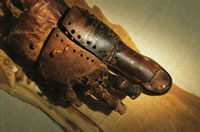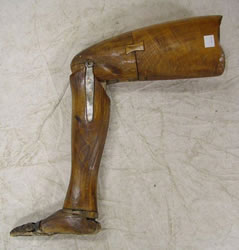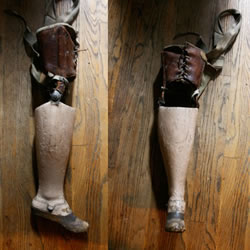THE ADVANCEMENT OF PROSTHESES THROUGHOUT HISTORY
Written by: Alexis Douglas.
Prostheses are commonly used to replace
parts of the body that are malformed,
lost due to trauma, or never formed
due to congenital defect. This paper
will examine the use of prostheses throughout
history and their advancement.
The most common use of prostheses
in history was replacement of a limb
due to trauma.1 Throughout
history, children who were born with
congenital defects or malformed limbs
were unfortunately viewed as ‘defective’
or ‘demonic’ and were not
often allowed to live long enough to
have need for prostheses.1
The first record of a functioning prosthetic
limb in history was found in the book
of Vedas from Sanskrit, India. This
book, believed to have been written
between 3,500 and 1,800 B.C. was a historical
record of the time period. One entry
stated that during a battle with a neighboring
territory Queen
Vishpla, a warrior queen in ancient
India, received a blow that amputated
one of her legs. After a time, having
healed, she was fitted with an iron
leg in order to be able to return to
the battle field in defense of her kingdom
once more.1 While there is
written record of the limb, there has
been no discovery of the iron leg used
by Queen Vishpla, or one like it, in
that area of the world.
The ancient Egyptians also made false
limbs during the burial process of their
nobles and monarchs.2, 3
It was believed that if a body was not
made whole during the burial ritual,
the spirit of the individual would not
have the missing appendage in the afterlife.
In order to afford their kings and queens
every advantage possible in the afterlife,
“feet, legs, noses, ears—and
even penises” 2(p.
1) were replicated using wood or ceramic
and buried with mummified bodies.2
These limbs were purely aesthetic, and
showed no signs of ever being used by
the bodies they were attached to.2,
3
 In
the year 2000, archeologists in ancient
Egypt unearthed what was believed to
be the oldest functioning artificial
body part ever found.2-4
The device was estimated to be 3,000
years old (circa1065–740 B.C.).3
It was a replacement big toe
that was found attached to the mummy
of a woman estimated to be 50-60 years
old at the time of her death.2-4
Unlike the replacement limbs that had
been previously found, this one was
laced to the foot with a leather sleeve,
not just placed with the body.2,
4 The toe also had three bendable
joints and showed signs of wear on the
bottom and sides suggesting it had actually
been used during the woman’s lifetime.2-4
This early prosthesis was far more sophisticated
than prostheses that have been found
and dated after the fall of ancient
Egypt. In
the year 2000, archeologists in ancient
Egypt unearthed what was believed to
be the oldest functioning artificial
body part ever found.2-4
The device was estimated to be 3,000
years old (circa1065–740 B.C.).3
It was a replacement big toe
that was found attached to the mummy
of a woman estimated to be 50-60 years
old at the time of her death.2-4
Unlike the replacement limbs that had
been previously found, this one was
laced to the foot with a leather sleeve,
not just placed with the body.2,
4 The toe also had three bendable
joints and showed signs of wear on the
bottom and sides suggesting it had actually
been used during the woman’s lifetime.2-4
This early prosthesis was far more sophisticated
than prostheses that have been found
and dated after the fall of ancient
Egypt.
Archeologists have found evidence of
prostheses in ancient Rome that were
made to replace missing lower legs.5,
6 These devices date back to
300 B.C. and were made from a wooden
core coated with hammered metal plates.5,
6 The replacement limb was then
strapped with leather to the remaining
stump and used to replicate normal ambulation.5
These devices were formed by blacksmiths,
metalworkers, and armor makers because
they were skilled in the blending of
wood, metal and leather.5
The limbs found in ancient Rome lacked
the sophistication of joints found in
those developed by the Egyptians.
 Blacksmiths
and armor makers continued to be the
creators of prostheses through the Middle
Ages. During this time, the loss of
a limb was considered embarrassing and
unsightly, yet little was done to aid
these people.5 Knights who
were injured in battle were often the
only members of the population who were
afforded any method of concealment.
A knight would go to the same man who
constructed their armor, and request
a replacement limb made to attach to
their armor, so as to hide the embarrassment.
However, these prosthetic limbs were
heavy, solid pieces that only served
to disguise the fact that a limb was
missing as they weighed far too much
to be of use in combat..5 Blacksmiths
and armor makers continued to be the
creators of prostheses through the Middle
Ages. During this time, the loss of
a limb was considered embarrassing and
unsightly, yet little was done to aid
these people.5 Knights who
were injured in battle were often the
only members of the population who were
afforded any method of concealment.
A knight would go to the same man who
constructed their armor, and request
a replacement limb made to attach to
their armor, so as to hide the embarrassment.
However, these prosthetic limbs were
heavy, solid pieces that only served
to disguise the fact that a limb was
missing as they weighed far too much
to be of use in combat..5
The most frequently recognized forms
of early prostheses were made common
by seafaring men. Popular culture has
often labeled theses men ‘pirates,’
but any man who served on a ship frequently
faced the same risks. The use of rope
drawn sails often led to tangles in
the line that could ensnare a sailor
with a strong gust of wind. If an arm
or leg was caught in that rope, the
sailor, more often than not, lost that
limb.4 Sailors spent the
majority of their lives at sea, so when
a catastrophic injury occurred and a
sailor lost a limb, they made do with
whatever they could find on the boat.
For that reason, wooden shafts for legs
and metal hooks for hands became common
forms of limb replacement.4
In the 16th century, a French surgeon
named Ambroise Paré contributed
major advances in prosthetics such as
mechanical, hinged hands, and locking
knee joints. These implements were made
of metal, but unlike those utilized
by the Knights of the Middle Ages, these
devices could be used in activities
of daily life. A century later, a Dutch
surgeon by the name of Pieter Verduyn
created a lower-leg prosthesis that
involved “specialized hinges and
a leather cuff for improved attachment
to the body.” 4 (p
2) These drastic advances are still
utilized today as some of the basic
features of modern prosthetics.4
While these devices were highly useful,
they were complicated and expensive,
and few could afford them. However,
by the 1700’s, metal hooks and
wooden legs attached with leather straps
had became commonplace for individuals
with amputations.5
The Civil War in America (1861–1865)
served to make the need for prostheses
commonplace among formerly able-bodied
young men.5 Surgeons working
on surviving soldiers who fought for
the north conducted 300,000 amputations
over the course of the war.5
It is unknown how many amputations were
conducted on soldiers who fought for
the south.
The high demand for prostheses due
to the Civil War encouraged manufacturers
to make advancements. Prior to the war,
in 1818, a German dentist named Peter
Ballif developed a full arm prosthesis
that was designed to be controlled by
the movements of the opposite shoulder
and the torso.1, 4 In 1844,
a Dutch sculptor proposed a similar
device that was designed for use with
above the elbow amputations.1
In 1863, Dubois
Parmelee invented a socket to attach
both arm and leg prostheses that employed
suction to keep the prosthetic in place.1
The split-hook hand, which is still
used in modern day prostheses with a
few modification, was created in 1912,
by a man named Dorrance. Despite the
plethora of advancements available,
the metal hooks and wooden legs that
were developed centuries earlier were
still used. They became less common
however as government funding to support
those who had suffered amputations improved.6
There were also improvements in surgical
techniques, which enabled the residual
portion of the limb to be better shaped
to accept a prosthetic limb.6
 Following
World War I and II in 1945, the National
Academy of Sciences, an agency funded
by the United States government, established
the Artificial Limb Program.4,
6 This program was designed to
improve the design of prosthetic devices
through the funding and coordination
of research.4, 6 The U.S.
Veterans Association funded research
that developed mechanical arms with
a hook on the end that could open and
close by shrugging the shoulder.5
This gave the individual wearing it
the ability to grasp things. The agencies
combined funding to improve leg prostheses,
ushering in improvements in both above
and below-the-knee. Emphasis began to
be placed on how lifelike the replacement
limb appeared.6 Doctors and
engineers worked together to improve
both the function and the appearance
of prosthetic limbs. Creation of new
materials such as plastic, the advent
of computer aided design, and further
improvement in surgical techniques all
served to make prosthetic limbs more
functional and lifelike.5, 6
Following the Vietnam War, electronic
control of prosthetic limbs was introduced.5 Following
World War I and II in 1945, the National
Academy of Sciences, an agency funded
by the United States government, established
the Artificial Limb Program.4,
6 This program was designed to
improve the design of prosthetic devices
through the funding and coordination
of research.4, 6 The U.S.
Veterans Association funded research
that developed mechanical arms with
a hook on the end that could open and
close by shrugging the shoulder.5
This gave the individual wearing it
the ability to grasp things. The agencies
combined funding to improve leg prostheses,
ushering in improvements in both above
and below-the-knee. Emphasis began to
be placed on how lifelike the replacement
limb appeared.6 Doctors and
engineers worked together to improve
both the function and the appearance
of prosthetic limbs. Creation of new
materials such as plastic, the advent
of computer aided design, and further
improvement in surgical techniques all
served to make prosthetic limbs more
functional and lifelike.5, 6
Following the Vietnam War, electronic
control of prosthetic limbs was introduced.5
Today the number of people living with
an amputation is estimated to be between
400,000 and 1,000,000 in the United
States alone.5 Technology is advancing
to meet the demand for better devices.
The combination of plastic and carbon
fiber is becoming commonplace, making
these devices lighter, stronger, and
more durable.5 For prosthetic
arms, silicone based materials are being
used that make the limb more comfortable
to wear, and more lifelike in appearance,
even having a softer texture to the
skin.5 It is also becoming
commonplace to have a mold made of the
remaining limb and then have it mirrored
to create a replica that looks just
like the individual’s other arm.5
Advancements in computer technology
enables modern prosthetic limbs to adapt
their function during tasks like gripping
or walking.4
The most drastic difference between
modern prostheses and those of the past,
is in the interface between the prosthetic
device and the patient’s limb.4
This portion of the prosthesis is a
combination of the suspension system
and the socket.4 In the past
the suspension system for a prosthetic
limb was made from straps of leather
and buckles, and the socket was wooden
or metal lined with fabric. Most modern
prostheses combine the socket and suspension
system into a molded plastic socket
that uses suction to remain attached.
It must be carefully molded and padded
to prevent damage to the limb it is
attached to.4-7
This socket also makes the prosthesis
easier to put on and take off. This
is particularly helpful when the individual
has multiple prosthetic limbs. Having
multiple prosthetics is particularly
common in athletes. These athletes may
have separate prosthetics for activities
like running, skiing, or biking. The
prosthetics available to athletes are
considered state of the art, and have
some of the most extreme advances in
prosthetic technology. Those prosthetics
used by athletes for running hardly
resemble human limbs. They are carefully
crafted combinations of plastic, rubber,
and carbon fiber that are proportionally
fitted to the body.4 They
are carefully regulated during competition
to ensure that no advantage such as
extra limb length is being used.
Modern lower limb prosthetics for the
general population are much more versatile
than those of the past, however further
advances are still being examined. For
example, in 2007, research was conducted
to determine the benefits of adding
a motorized ankle to leg orthotics.8
This motorized ankle unit is designed
to mimic a normal gait. Current leg
prostheses are fixed at the ankle causing
uneven gait and possible lack of stability
during standing. The units created in
this study combined sensors to detect
minute movements at the ankle, and micro-motors
to adjust the ankle in response to instabilities.8
These units are still strictly experimental,
but have shown promise in a laboratory
setting.8
In upper body prosthetics, there have
been numerous recent developments as
well. Todd
Kuiken, known as the pioneer of
prostheses, specializes in upper limb
prostheses.9, 10 His research
has yielded a replacement upper limb,
attached at the shoulder, that can be
controlled by thought alone.9,
11, 12 Commonly used arm prostheses
can only accomplish one movement at
a time.12 This new prosthetic
utilizes a process called targeted muscle
reinnervation (TMR).4, 12
TMR “uses the residual nerves
from an amputated limb and transfers
them onto alternative muscle groups
that are not biomechanically functional
since they are no longer attached to
the missing arm.” 12(pl)
This procedure had success in a 2007
case study, indicating promise for the
device’s future use.
The most recent advancement in prosthetics
occurred in the U.K. and is being called
a ‘bionic hand.’13
It started as a project to help children
with congenital amputations in 1963,
and has evolved into a prosthetic hand
with five individually functioning digits.13
The device came into its own in the
year 2007 when a company called Touch
Bionics agreed to produce and sell
what they call the i-LIMB.
Since its debut in 2007, over 200 people
have been fitted with the device, including
injured soldiers returning from Iraq.
The company is currently working on
models for a full arm.13
This device raised the expectations
for prosthetic devices, and will be
able to improve the lives of so many
who have been disadvantaged for too
long.
The use of prosthetic implements has
always been with the intent of helping
someone with a disability to live a
more normal life. The advancement throughout
history has been paramount in making
this possible. Prostheses today help
people with amputations tackle the necessities
of life; ambulation, exercise, the ability
to grasp objects, and open doors on
their own. There are even special prosthetic
legs for women attending formal occasions
that are designed to wear heels.4
One of the first to be fitted with an
i-LIMB, an individual who had suffered
quadruple amputations, was able to see
a hand that was attached to him open
for the first time in 21 years.13
Improvements in prostheses are constantly
being made, between the athlete who
desires to run faster, and the mother
who wants to be able to brush the hair
of her child, demands for improvements
have been heard, answered, and will
continue to be for years to come.
references
|



